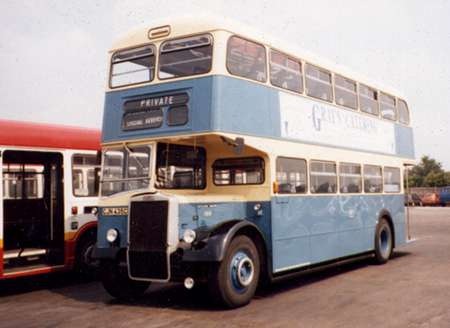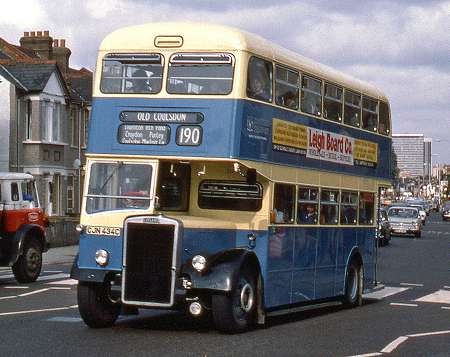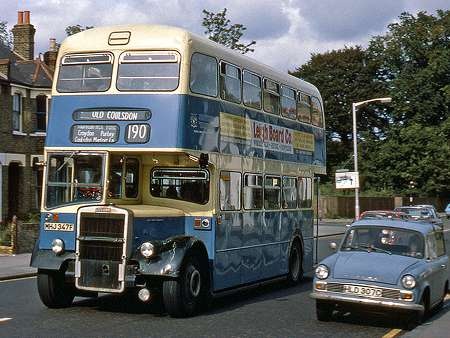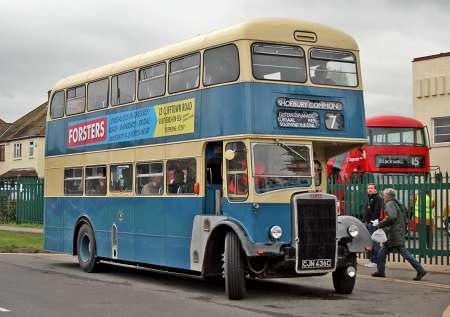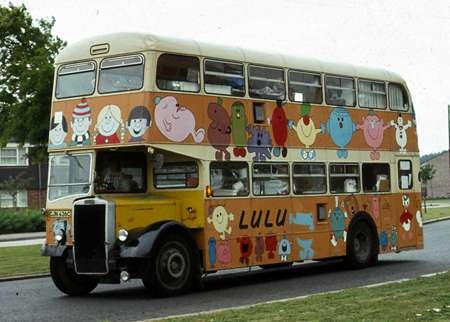Southend Corporation - Leyland Titan - CJN 438C - 338
Southend Corporation
1965
Leyland Titan PD3/6
Massey H38/32R
This picture was taken sometime in the early seventies at what is now to me an unknown location in Southend, it shows No 338 CJN438C one of a batch of twelve Leyland PD3/6s with Massey H38/32R bodywork delivered in April 1965 after Massey had changed to a severe upright front profile in stark contrast to it’s very curvaceous shape although personally I liked the upright look, so I imagine my view of most modern vehicles is quite obvious but then like most people who use the site live in the past like me.
Photograph and Copy contributed by Diesel Dave
07/07/14 - 07:59
I agree, Dave, that the upright front end looks better than those exaggeratedly backswept Massey front profiles of earlier days. Wonderful contrast in seating capacity (70 and 34) between this Southend Titan and the magnificent Thornycroft posted by Pete Davies, yet the overall lengths differ by only five feet or so. Each, in its way, a very handsome bus.
Ian T
07/07/14 - 08:00
I had just been riding on ex-Ramsbottom no 8, an East Lancs bodied PD3/4, at
Peterborough Bus Rally when I got home and opened up this superb shot. The sounds of the O.600
engine and ‘solid’ gearchanges still ringing in my ears. Sheer bliss!
I can’t make my
mind up whether I preferred the curvy Massey front or this upright version but whichever front they
had Massey bodies always looked so solid and well built. The Southend livery is a classic too, a
lovely shade of blue.
Thanks for the post it has really made my day.
Philip Halstead
07/07/14 - 08:02
I don’t know a lot about this vehicle (CJN 435C) only that my boss borrowed it for me for driver training at Midland Red North it was in beautiful condition and must be a preserved vehicle. Around about 1994.
Michael Crofts
07/07/14 - 10:17
This batch of superb vehicles were delivered during the time when I was regularly on Leeds - Southend Airport tour feeders for Wallace Arnold. I had already fallen in love with "The County Borough" and the Corporation’s glorious and fascinating fleet, but these buses really were the bees’ knees. Avoiding that possibly exclusive word "favourite" I’m sure that these must be amongst the most handsome and well proportioned "back loaders" of all time.
Chris Youhill
07/07/14 - 15:50
I think there is scope for confusion in respect of what is meant by a
‘curvy’ Massey body. In the photograph linked to below, the right-hand vehicle has one of the
the most curvy Massey bodies produced, these were current late 1940s to mid-1950s. The vehicle on
the left has a body which isn’t quite so curvy, this style was current mid-1950s to mid-1960s - but
it’s still more curvy than the upright style shown above, produced in the very few years from the
mid-1960s until the end of Massey production.
These two additional buses are also from
Southend, one of Massey’s most regular customers. www.sct61.org.uk/ss307b
David Call
07/07/14 - 15:51
I think that the curvy Masseys look dreadful, but I agree with everyone else that these "upright" versions look rather special.
David Oldfield
08/07/14 - 07:30
Massey seemed to increase the ‘curved back’ angle for lowbridge bodies more than they did on highbridge versions. The Daimler in the photo linked above is a good example. I don’t recall any lowbridge versions being built with the ‘upright’ front but stand to be corrected. By the time the upright design was introduced lowbridge (ie sunken gangway type) buses were pretty rare.
Philip Halstead
08/07/14 - 07:30
Thanks for your thoughts in respect of this and my posting of the Portsmouth
Thornycroft, Ian. I was more familiar with the Massey double deckers of Morecambe & Heysham than the
more upright version seen here.
I have a (bought) slide of an A1 Service Fleetline with a
Massey body of the same era, "B" suffix. It seems to me to be more reminiscent of the MCW
offering. At least we should be thankful it isn’t like the Park Royal which Southampton had on PD2,
PD2A and Regent V chassis!
Pete Davies
08/07/14 - 07:31
David O, I have to totally agree with your comments about the Massey bodies. This upright style I would probably rate as my joint 3rd favourite style of half-cab double decker. As a patriotic Yorkshireman 1st has to be the early 1950’s Roe bodies,2nd the ECW on Bristol K chassis & joint 3RD the postwar Lelland
Keith Clark
08/07/14 - 07:32
These buses had red steering wheels to denote that they were highbridge and therefore banned from certain routes.
Philip Carlton
08/07/14 - 07:32
I enjoyed the ‘spot the difference’ contest between these two photos of
the upright Massey bodies - I much prefer these to the dated curvy style, even though I used one of
the latter as my wedding transport.
The difference is, of course the London Transport stencil
holders, which remained on this batch of buses after their hire to Croydon Garage to work route 190
Thornton Heath - Old Coulsdon in 1975. I think that Southend felt that they were some sort of badge
of honour and the stencil holders remained on these buses, i think, to the end of their days,
despite serving no purpose back home.
Petras409
08/07/14 - 07:33
The intermediate style of post-war Massey bodywork (as displayed by Southend 307 in the above linked picture) was available to the end of Massey production, concurrent with the more upright style. Very few operators took the upright style - Chester, Wigan, and Birkenhead spring immediately to mind as users, in addition to Southend.
David Call
08/07/14 - 08:00
The link given by David Call does not compare like with like. Both vehicles depicted are the lowbridge type, which had a more exaggerated curvature to the frontal profiles than the corresponding highbridge versions. Alan Murray-Rust’s OBP gallery ‘Massey Bodies with Independents’ includes examples of the later highbridge design before the introduction of its upright successor. Personally, I prefer the older style - the upright type has an air of ungainliness that is absent from the classic East Lancs design that Southend turned to for its last PD3s. Massey were very late entering the rear engined bodywork market - the first examples of the firm’s new design entered service with Maidstone in January 1967 - but the initial concept must have been drafted much earlier. I think that the upright design for front engined chassis was conceived to allow a degree of commonality of components with the rear engined body. These Southend PD3s travelled far beyond the borough boundary. From September 1975 they appeared from Croydon Garage on London Transport service 190 (originally a Croydon Corporation tram route as far as Purley) between Thornton Heath High Street and Old Coulsdon. This was at a time of market domination by Leyland, when the entire bus industry was suffering late deliveries of new vehicles and severe shortages of spare parts. LT hired ten PD3s on a rotational basis from Southend, the vehicles being returned to their owner for maintenance. The drivers ’lucky’ enough to be trained to drive the clutch/synchromesh gearbox, ‘modestly’ braked Titans must have found themselves in another world entirely from the fully automatic, hydraulically braked Routemasters. I have to say that the PD3 design certainly had the heaviest controls of all the buses I have ever driven.
The pictures show Massey bodied CJN 434C and East Lancs MHJ 347F at South Croydon en route to Old Coulsdon. When LT finished with these buses they passed on to London Country, who based them at Harlow Garage. (Some of the drivers’ comments that I heard cannot be repeated on a family site like OBP.) It is a tribute to the indestructability of the PD3 that it survived some pretty unsympathetic treatment in unfamiliar hands. London Country finally ended the hire arrangement at the end of January 1977. One aspect of this tale that intrigues me is how Southend (and Maidstone as well - between six and nine Atlanteans were on loan to Chelsham Garage in 1977)) should have so many buses surplus to requirements that it could hire them out to others.
Roger Cox
08/07/14 - 11:10
Petras 409 - I’ve often, over the years, reflected wryly on the displeasure that the London Transport "pre-selector" chaps will have expressed when driving the excellent PD3s. Similarly just after the War when borrowed Bristol Ks and LT’s own new Leyland PD1s appeared - ah, I’m going into happy memories now of the glorious PD1s - Yorkshire ex Bristol and ex Lancashire examples which gave me so much pleasure both privately and in my career.
Chris Youhill
08/07/14 - 11:11
A friend of mine who was an operator of high end coaches had a saying: I want professional drivers, not steering wheel attendants. This portrays the eternal problems. Leylands, such as these, were definitely engineers buses - solidly built with reliable operation in mind. They were not "drivers" buses - heavy and ponderous with suspect brakes. [Although an enthusiast/enthusiastic driver may take a pride in taming the beast and driving it well.] This could be said of all Leylands up to about 1970 (when power steering was becoming universal, along with better braking systems). On the other hand, AECs were drivers buses - in the words of another operator friend, thoroughbreds. Sadly, thoroughbreds can be temperamental and the wet liner 470s and 590s let the side down in the reliability stakes - and did quite a lot to tarnish the good reputation of AEC. Subsequent engines (505, 691 and 760) regained the old standards, but too late, as many had abandoned ship by then.
David Oldfield
09/07/14 - 07:59
Chris Y is so right when he talks about London Transport’s drivers being wedded to their pre-selective vehicles! Among other cases were the eight brand-new all-Leyland PD1 STD class allocated to Potter’s Bar Garage in late 1946. They replaced some 1929 open-staircase LT’s but, within the month, they had been swapped with Loughton Garage’s almost-as-old LT’s!
Chris Hebbron
09/07/14 - 07:59
Back to the Masseys. I prefer what one commentator was known to call an honest box (shape). I think there is far more class in a Setra or Van Hool than in fussy, curvy coaches just as I am an admirer of the Mancunian, the standard Park-Roe body (1968-1981) and the subsequent ECW/Roe body on the Olympian. All outside our time frame here, but examples of simple classic design.
David Oldfield
09/07/14 - 07:59
In my own defence perhaps I could make the point that I was trying to show that there were various degrees of ‘curvy’ Massey bodies. The fully sweptback style I think only featured on lowbridge bodies, highbridge of the period having much the same sort of profile as the mid-1950s to late-1960s style. In respect of the latter, I’ve never been conscious of any great difference in the rake between highbridge and lowbridge models.
David Call
09/07/14 - 07:59
I wonder if being a "drivers bus" equates to "being popular with drivers" though. Certainly I read in one of the many articles/books by that recent great loss to the transport world, Geoffrey Hilditch, (not sure which one though) that at Halifax it was custom to keep a Regent V conspicuously parked in the depot doorway, as a warning to any crew asking for a changeover, presumably from a PD2 or PD3, that that would be the vehicle they would be given as a replacement. Or was it just as in so many fleets, the minority vehicle type tends to be less popular? I would imagine noise levels in the cab of any synchromesh Regent V or Renown would be pretty high which some drivers probably did not appreciate.
Michael Keeley
12/07/14 - 06:44
The practice of leaving an even more unpopular replacement vehicle in a conspicuous place was not restricted to Halifax. I’m sure I’ve read of the practice elsewhere and certain that Charles Baroth used the same deterrent at Salford, even on the trams.
Orla Nutting
12/07/14 - 09:11
Having undesirable vehicles available for changeovers was a practice which was widespread. Towards the end of my stay with Burnley & Pendle it was accepted that if your vehicle needed to be changed, the replacement would be a Bristol RE, which was not only the oldest type in the fleet, but compared poorly with the contemporary standard. Didn’t this practice deter drivers from reporting bona fide defects?
David Call
14/07/14 - 07:50
It’s good to see the Massey and East Lancs versions together like that. I
agree that the East Lancs is more elegant, but it’s also more bland; the Massey has more character.
For some strange reason they put me in mind of the difference between dark chocolate and milk
chocolate. I prefer dark -
I prefer the Massey.
Peter Williamson
14/07/14 - 09:49
Compare the Massey body to that of Manchester’s 3520 in the current thread about Manchester’s 3629. In 1958 Manchester wanted more upper deck space and had Burlingham straighten and tone down their somewhat over curvy design and came up with this elegant design - which looked far better on the Leyland chassis than the Daimler version. Massey seemingly followed suit.
Phil Blinkhorn
02/01/15 - 09:16
The top picture of 338 I believe was taken in London Road Southend, just by Victoria Circus. The bus is heading west (it is a 3A to Canvey Island). Buses don’t use that part of the road any more since the road behind this bus has now been pedestrianised and a bypass (Queensway) was built just to the north.
Brinic
16/01/15 - 08:28
Photo of CJN 436C at Castle point Open Day, also two photos of the same vehicle as a playbus
Brian Pask
18/10/15 - 07:45
I was delighted to see the photograph of Southend 335 (CJN 435C) at Midland
Red North’s Cannock Depot. My introduction to the Massey Highbridge PD3s was when one picked me up
on my way to school when first introduced in 1965 and made an impression with that smell of
‘newness’. Nineteen years later a friend encouraged me to help at the Castle Point Transport
Museum on Canvey Island and I found myself helping to extract a stripped vehicle from the rear of
the building ready for the collection by the scrap merchant. Once it had been moved an old friend
was revealed - 335 - and I asked what was happening to the ‘Old Lady’ sadly down on her luck.
The answer was blunt - she would be leaving for the scrap yard once the other vehicle had left. When
I mentioned my memories of 335 and her sisters the owner offered to sell at scrap value if I was
interested - and in a moment of madness I agreed.
Within a month 335 was removed from the rear
of the building and tucked-up inside the Museum. Progress was slow and the engine was found to have
a defective block. In the July of 1986 my dad, who had been helping me, suddenly died and my wife
and I decided 335 would be rebuilt in memory of dad. The rebuild was extensive with the bodywork
undertaken by Roy Hawkes - including new rear platform, staircase, stress and external panels. At
that time was working part-time for Southend Transport and had got to know Chris Hilditch who was
Chief Engineer as well as other senior staff. With the bodywork renewed I offered the mechanical
overhaul, repaint and seat re-trimming to Southend Transport. I remember the day she was towed from
Canvey to Tickfield Works in plain aluminium finish and the greeting the ‘Old Lady’ was given
on her arrival. Chris made me a promise and he kept it. On the first anniversary of dad’s death,
with the engine from a Portsmouth PD2 installed, 335 made her first test run. At the following
Canvey Open Day she worked on the Shuttle Service crewed by Southend Transport Drivers. Chris moved
to Midland Red North and 335 fitted the bill to retrain drivers with automatic licences to drive
stick motors. She did two periods of duty at MRN but also had a spell with Southend when her sister,
by then on loan as a trainer, was in the works. After regaining her PSV status she worked for the
late Brian Smith of S & M Coaches on school contracts until rear-platform vehicles were phased-out.
She also spent time at Mangapps Railway Museum at Burnham-on-Crouch. Unfortunately the on-set of
arthritis meant it was becoming difficult to drive her and a friend, Carl Ireland, stored her for me
where she caught the eye of a French gentleman. After a fresh repaint she came south for the Canvey
Open Day allowing me a last opportunity to drive her before crossing the Channel where she was well
looked after. Eventually she returned and was gutted to be a Playbus in the Southend area. After
that I quit ‘bus preservation but I have been told she is back in preservation and would be
delighted to hear how she has fared. I cannot recall the year I sold her but it must have been
around 1989.
Frank Spence
28/10/15 - 07:04
Many thanks to Frank for having preserved this bus and to the snap a photo of
old 335, it really was a magnificent effort to get her back to better than new standard about 1987
and I was to leave Southend in 1988 to join MRN, I saw this vehicle as above in the yard of Cannock
and recognised it immediately, I had a bit of sleeplessness as I was really worried about how much
it cost Frank to have the bus rebuilt at professional fees even doing the best I could, I do hope
the vehicle survives and what a waste to turn it into a playbus the interior was done in original
style by Seph our trimmer in original new moquette.
Good luck I hope it survives I too would
be pleased to here how it goes on.
Chris Hilditch
04/05/16 - 06:23
I was delighted to see Chris Hilditch’s response to my notes on Southend Transport 335. He was very supportive of my efforts to return the Old Lady to her former glory and that enthusiasm extended to everyone in Tickfield Works. I was fortunate to be on Southend Transport’s part time driver panel so I was able to come and go at the Works whenever I wanted to monitor the progress and discuss directly with the staff any issues. Even the spiders in the deepest recesses of the stores were disturbed as odd PD3 parts were discovered. When 335 was stripped to become a playbus the seats survived and found their way into her sister, Lulu, as she was returned to her former glory by new owners.
Frank Spence
28/02/17 - 06:11
The Top picture is in London Road, Southend virtually opposite what was at the Time ENOC’s Southend Depot. Behind the bus is Southend Victoria Circus & an area nicknamed ”Cobweb Corner” in Tram & Trolleybus days due to the high amount of Overhead wires. I remember Chris Hilditch wayback when I was at ST in 1986 as a 18 year old handyman-31 years later I part-run a Bus & Coach company in Rochford with 3 Routemasters.
James Sadd
13/08/17 - 07:41
Glad I stumbled on this site! CJN 436C (Lulu2 above) was sited in the grounds of Darlinghurst School for a while and somewhere along the way was bought by my father, Don Hebden who was Duty Crew at London Road. 436 arrived in Tickfield and stood there for a number of years. Eventually it was sold to someone in the Worthing area, I believe. My dad reported that with a bit of attention, it started up and ran OK and was then driven to Worthing under its own steam! I actually heard it running as my dad’s mobile phone made a "pocket call" to mine part way through proceedings! I have a photocopy of the log book somewhere which I found when clearing out his paperwork after he died. Greetings to Chris Hilditch, too - fellow piper in SSPB!
Mike Hebden
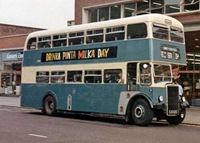 Vehicle reminder shot for this posting
Vehicle reminder shot for this posting
02/11/18 - 07:34
I came across this publicity shot of Southend 335 (copyright unknown), which now resides at PenYBanc Farm, not too far away from where I now live in West Wales. It has been converted to an upmarket camper van, although it is stationary on site. From previous comments, it seemed that 335 was well on the way to being preserved in running condition. Anybody know what happened? I will have a look at the bus at some time and get some more photos.
David Field
Quick links to the - Comments Page - Contact Page - Home Page

